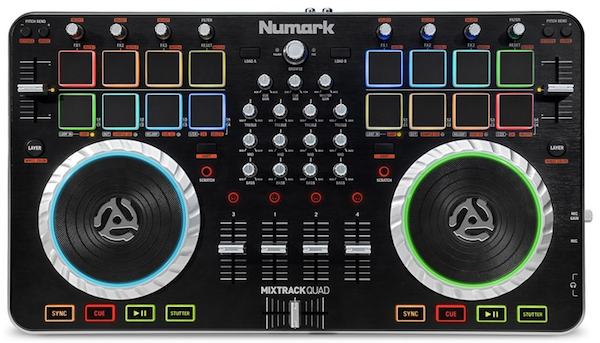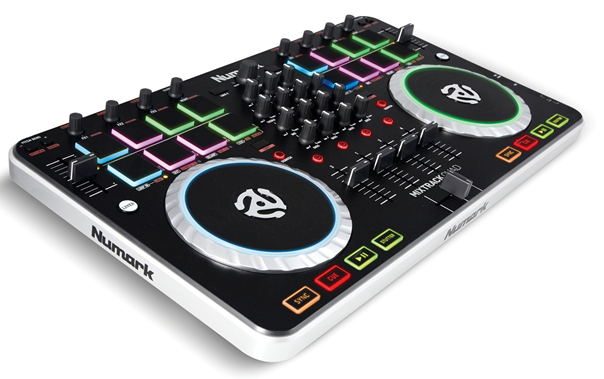Video Review
A four-channel DJ controller for this price? It’s certainly the selling point of the Numark Mixtrack Quad, which does indeed have four physical channels for true four-deck software mixing. It also had 16 colour-coded control pads, and nice jogwheels inherited from the Mixtrack Pro 2 (which it is basically the four channel version of). But without Serato DJ Intro in the box and thus the Serato upgrade path, as provided with the Mixtrack Pro 2 (this comes with Virtual DJ LE, due to the latter supporting four decks which the “Intro” version of Serato doesn’t), does it add up to value for money? Let’s find out…
First impressions and setting up
Numark has got this consumer DJ controller thing right. Sure, the Numark Mixtrack Quad is basically a plastic box, but it’s slimmer, better finished and more pleasing to the eye than the original Mixtrack Pro, which it and the Mixtrack Pro 2 are natural successors to – and that didn’t do too badly! The jogwheels feel really good, and being relatively compact, the controller also feels sure and stable. Basically, it’s well built for the cash.
The knobs for the four channels are necessarily close together and so feel cramped, but the performance pads have plenty of space to breathe. The unit’s budget credentials show in its inputs and outputs, with just a microphone input, and a single set of RCA outputs for master out, plus headphones.
At least with the latter there’s 1/8″ and 1/4″ options, but actually on controllers at this end of the market, I would like to see 1/8″ jack master outputs too (after all, many people will be using this with powered computer speakers, and that’s what such speakers tend to want to plug into).
Getting it working is really easy. It’s a class complaint so no drivers, just install Virtual DJ LE from the CD (there should also be a download option too in this day and age) and plug it in. No audio configuration at all; everything just works. Top marks there. Add your speakers and headphones (and microphone if you want – the mic thru has a volume control too) and you’re ready to go.

In use
The version of Virtual DJ LE supplied has four decks, and the colour coding between the software and hardware is excellent. Each deck has a clear colour, and when you switch (using the “layer” buttons) between each pair of two decks on the left and right of the screen/controller, the colour coding on the controller changes to show you the deck you’re controlling. It’s intuitive, and it works smoothly. I miss “gain” controls (pre-fader volumes, for the uninitiated), although Virtual DJ does have its own input gains that it sets automatically, and you can always adjust these on the screen if you wish.
Most of the rest of the stuff you’d expect on a DJ controller is there, and there are even filter controls (the far right of the four FX knobs at the top of each deck takes care of that), although weirdly these don’t seem to turn the filter knobs on the software screen. They sound average – as do all the effects in Virtual DJ, which are as limited as they are disappointing. This is the same for all current versions of the LE software, and indeed the “pro” software if you don’t plug in external FX.
Most of the creative “action” happens around the eight pads. They’re not “drum pads” as the box proclaims, in that you can’t use all eight for finger drumming or anything like that. They’re just big buttons. The top ones control looping, the bottom four are switchable between manual (although still beat-tied) looping, cues and sampler triggers. There is no sample volume control on the controller; you have to do that on the screen.
One nice addition is a Slip mode, which lets you large it up on the cues, scratching and so on, and when you finish, it returns to where it would have been in the track had you not done so. It’s big with Serato and Traktor right now, so good to see it implemented here too.
The jogwheel performance is as good as any Virtual DJ controller; it is tight and responsive, and although forward spins are unconvincing, backspins are good. Sound quality is perfectly acceptable for this price point and I certainly wouldn’t let it stop mew playing small gigs on it.

Conclusion
If Numark set out to bring the cheapest true four-channel software DJ controller to the market, I am pretty sure it’s succeeded here. The Numark Mixtrack Quad is fun to use, has some nice innovations, and it’s clear the right kind of thinking and decision-making has happened between the hardware and software engineers to make it intuitive and fun to use.
Downsides? As mentioned above, the pads are trendy right now but they’re just another way of controlling functions that could be on normal buttons, and also I didn’t like the lack of gain controls.
But for many I suspect the biggest disappointment here will be that it is tied to Virtual DJ – or rather, you can’t use it with Serato too, like most of the rest of Numark’s controllers. This is presumably because Serato DJ Intro won’t work with four decks, which Virtual DJ LE in this instance will. It means you can’t try all software out on this like you can on the Mixtrack Pro/2.
Despite that, you’re getting a decent entry-level DJ controller that is good enough to learn the basics of DJing on and that should last you until you’ve got that first couple of years under your belt and you’re ready to make your next move. If four decks are important to you, definitely take a look – it’s great value.
Do you own the Mixtrack Quad? Does it tempt you? Please share your thoughts on this DJ controller in the comments below.








